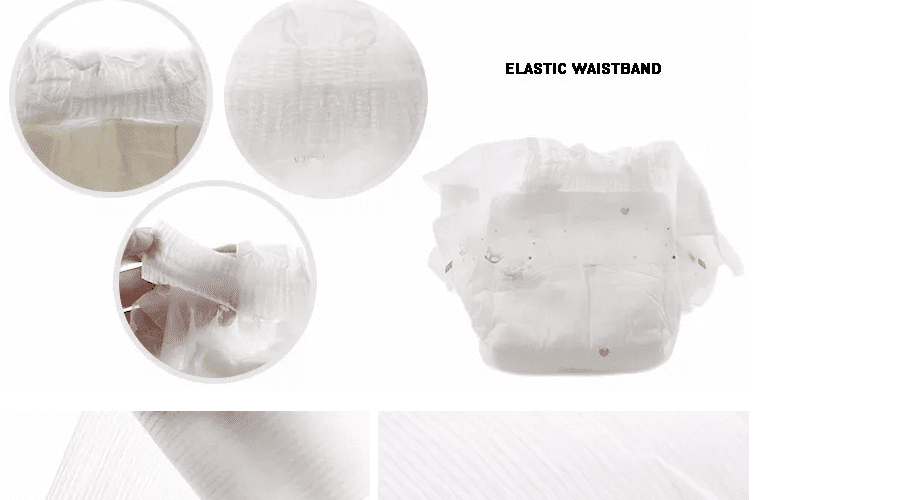The most common diaper fillings are SAP, cellulose, polypropylene, and polyethylene. Not all brands use these diaper materials, however, and some are natural and plant-based.
Polypropylene Nonwoven
A nonwoven of polypropylene is used in diapers to transfer liquid to absorbent materials. Besides offering good absorption, it is soft against the skin and won’t irritate it. It is made from biologically inert polymers that are safe for diapers. Polypropylene is lightweight and flexible, but not biodegradable.
Polyethylene film
On the backsheet of diapers, a polyethylene film keeps moisture inside the diaper while allowing airflow. As a petroleum-based plastic, it is not biodegradable and undergoes rigorous testing and safety evaluations. Some diapers use diaper raw material made from renewable and natural sources as the backsheet.
Super Absorbent Polymer (SAP)
There are several ingredients in disposable diapers that make them so effective, including SAP, which is fine granules that absorb moisture. These diaper beads increase moisture retention and sodium polyacrylate is the most common diaper filling compound. Diapers can be filled with SAP, but it is not biodegradable.
Cellulose/Pulp
A diaper core contains cellulose, a type of wood pulp fluff. Due to its high fiber to weight ratio, this pulp is good at absorbing liquid and locks it in place. This pulp keeps your baby dry for longer. When not bleached, it is safe and biodegradable.

Dyes
As long as dyes are made from plant-based sources, they cannot be biodegradable. They are used for wetness indicators and diaper prints. Most dyes in diapers are non-sensitizing pigments that undergo safety tests. Most diapers do not contain dispersed dyes, which are dangerous. Babies with sensitive skin might be allergic to dyes.
Bromophenol blue
Diaper chemicals like bromophenol blue are used as a wetness indicator. They are yellow when dry, but turn blue when wet with slightly alkaline pH like urine. Wetness indicators are placed inside the diaper layers and do not touch your baby’s skin. They are not carcinogenic, but can cause skin irritation if absorbed.
Phthalates
In diapers, phthalates are chemicals used to soften plastic and make the diaper more flexible. Phthalates can leach out and be absorbed by the skin.
Dioxins
As a result of bleaching the wood pulp, dioxins are introduced into diapers through chlorine. Diaper raw materials contain dioxins, which are linked to a higher risk of cancer, hormone disruption, and developmental problems. They are believed to increase the absorbency and cushioning of cellulose fibers. They are not biodegradable and are harmful to the environment.
Elastomeric
For the leg and waist elastics to be glued together with nonwoven materials, elastomeric is used. In addition to providing a better fit for pull-up diapers, elastomeric also increases elasticity and bonding strength. This makes the diaper stretch and recover its shape better. It is safe for diaper use.
Elastics Lycra/Spandex
Polyurethane or polyester is used to make Lycra and spandex diapers. As they are non-irritant and safe for diaper construction, they provide a better fit and are soft and flexible. They are highly effective and comfortable for your baby. However, elastics do not degrade.
Fastening tape
When you use adhesive tape to attach your diaper to your baby, it is safe to use. Hook and loop tape is adjustable while being gentle on the diaper and is not biodegradable. Adhesive tape can tear the diaper when opened and is not biodegradable.
Adhesives
It is usual to use hot melt adhesives to join diaper raw materials, usually SIS/SBS based. The adhesive allows for movement and prevents leaks, as well as keeping the diaper soft and comfortable. It is considered safe and does not release toxic fumes.
Colorants
In diapers, colorants are used to make the prints more appealing. They are non-sensitizing pigments bound into the fibers of the nonwoven material. Colorants are not biodegradable.
Fragrance Lotions
However, fragrance lotions must meet IFRA safety standards despite introducing unnecessary chemicals into diapers. Often, lotions can be found in the lining of your baby’s diaper and transfer to his or her skin. Barrier lotions are made from pharmaceutical-grade petrolatum, stearyl alcohol, and aloe. They aren’t biodegradable and can irritate sensitive skin.





























